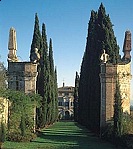| Comune: | Sovicille |
| Località: | Cetinale |
 La villa fu costruita tra il 1676 e il 1678 dal cardinale Flavio Chigi su progetto dell'architetto Carlo Fontana, allievo del Bernini, per celebrare l'elezione al soglio pontificio di Fabio Chigi con il nome d'Alessandro VII. Questa non fu mai un luogo di rappresentanza ma la residenza dove i Chigi si ritiravano per brevi periodi di riposo. Tre fasi contraddistinguono la costruzione del complesso: la prima corrisponde all'edificazione della villa, i suoi annessi e il giardino formale (1676-1688); la seconda alla realizzazione del parco della Tebaide (1698-1705); la terza alla costruzione del Romitorio (1716). L'edificio, a pianta quadrangolare, si sviluppa su tre piani fuori terra. Il prospetto principale è caratterizzato essenzialmente dall'elaborata doppia scalinata a forbice che si conclude con il grande portale centrale in marmo al primo piano. Questo è inquadrato da due colonne bugnate e coronato da un timpano triangolare fortemente aggettante sopra il quale si trova lo stemma dei Chigi. Il prospetto retrostante è composto da due avancorpi laterali aggettanti rispetto alla parte centrale. Questa è forata al piano terra da tre arcate sormontate da un falso loggiato con balaustra lapidea. Tutte le aperture e le arcate del porticato sono incorniciate da mattoni, che contrastano con le bugne in pietra che segnano gli spigoli del fabbricato. Grandi stemmi gentilizi decorano ogni apertura del piano nobile. Il giardino formale conosciuto come "giardino degli agrumi", che si sviluppa sul retro della villa, è composto da aiuole a disegno geometrico bordate da siepi di bosso. Tutte le aiuole sono ornate da pavoni scolpiti nel tasso e da statue. Il restante spazio esterno è impostato su un lungo asse rettilineo segnato da un basso muro coronato da busti marmorei. L'asse, che inizia con un'esedra, prosegue lungo un viale di cipressi e dopo aver attraversato un monumentale portale giunge alla villa. Il portale ornato internamente sui lati d'entrata da due nicchie con statue, è completato in alto da obelischi e busti scultorei decorativi. L'asse prosegue oltrepassando la villa e il giardino formale continuando il suo percorso fino a terminare con la colossale statua dell'Ercole, eseguita nel 1687 da Giuseppe Mazzuoli, un rustico colosso in pietra nascosto nel bosco lontano dalla dimora. A nord della villa, su un'area boschiva venne realizzato il parco della Tebaide. All'interno del parco, che prende il nome dalla zona desertica dell'alto Egitto abitata nel medioevo dagli eremiti cristiani, si dipana un tortuoso cammino di penitenza, tra cappelle votive, croci in pietra e numerose sculture di frati in ginocchio. Collegata alla villa, mediante una rapida scalinata scavata nella roccia detta Scala Santa, si trova il Romitorio aggiunto nel 1716. Con questo intervento venne accentuata l'importanza dell'asse che si prolungò fino alla sommità della collina. Il cardinale Flavio Chigi lasciò Cetinale ai nipoti, i quali la conservarono per tre secoli fino al 1977 quando fu acquistata dal parlamentare inglese lord Antony Lambton, che condusse un attento restauro conservativo, riportando Cetinale all'antico splendore.
La villa fu costruita tra il 1676 e il 1678 dal cardinale Flavio Chigi su progetto dell'architetto Carlo Fontana, allievo del Bernini, per celebrare l'elezione al soglio pontificio di Fabio Chigi con il nome d'Alessandro VII. Questa non fu mai un luogo di rappresentanza ma la residenza dove i Chigi si ritiravano per brevi periodi di riposo. Tre fasi contraddistinguono la costruzione del complesso: la prima corrisponde all'edificazione della villa, i suoi annessi e il giardino formale (1676-1688); la seconda alla realizzazione del parco della Tebaide (1698-1705); la terza alla costruzione del Romitorio (1716). L'edificio, a pianta quadrangolare, si sviluppa su tre piani fuori terra. Il prospetto principale è caratterizzato essenzialmente dall'elaborata doppia scalinata a forbice che si conclude con il grande portale centrale in marmo al primo piano. Questo è inquadrato da due colonne bugnate e coronato da un timpano triangolare fortemente aggettante sopra il quale si trova lo stemma dei Chigi. Il prospetto retrostante è composto da due avancorpi laterali aggettanti rispetto alla parte centrale. Questa è forata al piano terra da tre arcate sormontate da un falso loggiato con balaustra lapidea. Tutte le aperture e le arcate del porticato sono incorniciate da mattoni, che contrastano con le bugne in pietra che segnano gli spigoli del fabbricato. Grandi stemmi gentilizi decorano ogni apertura del piano nobile. Il giardino formale conosciuto come "giardino degli agrumi", che si sviluppa sul retro della villa, è composto da aiuole a disegno geometrico bordate da siepi di bosso. Tutte le aiuole sono ornate da pavoni scolpiti nel tasso e da statue. Il restante spazio esterno è impostato su un lungo asse rettilineo segnato da un basso muro coronato da busti marmorei. L'asse, che inizia con un'esedra, prosegue lungo un viale di cipressi e dopo aver attraversato un monumentale portale giunge alla villa. Il portale ornato internamente sui lati d'entrata da due nicchie con statue, è completato in alto da obelischi e busti scultorei decorativi. L'asse prosegue oltrepassando la villa e il giardino formale continuando il suo percorso fino a terminare con la colossale statua dell'Ercole, eseguita nel 1687 da Giuseppe Mazzuoli, un rustico colosso in pietra nascosto nel bosco lontano dalla dimora. A nord della villa, su un'area boschiva venne realizzato il parco della Tebaide. All'interno del parco, che prende il nome dalla zona desertica dell'alto Egitto abitata nel medioevo dagli eremiti cristiani, si dipana un tortuoso cammino di penitenza, tra cappelle votive, croci in pietra e numerose sculture di frati in ginocchio. Collegata alla villa, mediante una rapida scalinata scavata nella roccia detta Scala Santa, si trova il Romitorio aggiunto nel 1716. Con questo intervento venne accentuata l'importanza dell'asse che si prolungò fino alla sommità della collina. Il cardinale Flavio Chigi lasciò Cetinale ai nipoti, i quali la conservarono per tre secoli fino al 1977 quando fu acquistata dal parlamentare inglese lord Antony Lambton, che condusse un attento restauro conservativo, riportando Cetinale all'antico splendore.
Built between 1676 and 1678 by cardinal Flavio Chigi, to a design by the architect Carlo Fontana (a pupil of Bernini) to celebrate the election of Fabio Chigi as Pope Alexander VII, the villa was never used for reception purposes, but as a private residence to which the Chigi would retreat for brief periods of repose. The complex was built in three stages: the first, involving the construction of the villa, its outbuildings and the formal garden (1676-1688); the second, involving the laying out of the Tebaide park (1698-1705); and the third, involving the building of the hermitage (1716). The quadrangular building has three floors above ground level. The main elevation is characterised mainly by the elaborate double staircase that culminates in the large central marble portal on the first floor. This is framed by two rusticated columns and surmounted by a heavily protruding triangular tympanum, topped by the Chigi crest. The rear elevation consists of two avant-corps at the sides and a central section. At ground-floor level, this slightly receding section has three archways surmounted by a faux loggia with stone balustrade. All the windows and the archways of the portico, which are brick framed, contrast with the buildings hewn stone corners. Large noble family crests decorate each of the windows on the piano nobile. The formal garden, which lies at the back of the building and is usually referred to as the "citrus garden", consists of geometrically designed flower-beds edged with box hedges. All the beds are adorned with sculpted peacocks and statues. The remaining outdoor space follows a long straight axis marked by a low wall topped by marble busts. This axis, which begins with an exedra, continues along a cypress-lined avenue and, after crossing a monumental gateway, reaches the villa. The portal, embellished on both sides of the inside of the entrance by two niches with statues, is topped by obelisks and decorative sculpted busts. Beyond the villa and the formal garden, the axis continues as far as an enormous statue of Hercules, created in 1687 by Giuseppe Mazzuoli, a rustic stone colossus hidden in the wood, well away from the house. The Tebaide park was created in a wooded area to the north of the villa. The park, which takes its name from a desert region of Upper Egypt, inhabited in the Middle Ages by Christian hermits, has a winding "pathway of penitence", with three votive chapels, stone crosses and numerous sculptures of kneeling friars. Connected to the villa by a steep flight of steps hewn out of the rock, known as the "holy stairway", the hermitage was added on in 1716. This additional construction scheme accentuated the importance of the axis which was thus extended all the way up to the top of the hill. Cardinal Flavio Chigi left the Cetinale estate to his grandchildren, who retained the property for three centuries, until it was bought in 1977 by the English peer Lord Anthony Lambton, who carried out careful, conservative restoration work that restored Villa Cetinale to its former glory.

